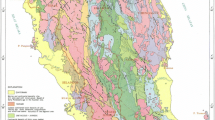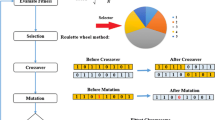Abstract
The mining of iron ore, an essential raw material for iron and steel industry, is of prime importance among all mining activities undertaken by any country. Therefore it is important that the iron ore mining should be environment-friendly and sustainable. Ripper Dozer combination is one of the most commonly used excavation methods in Iron ore mines of Goa because of the presence of soft and friable rock mass and also it can bring the mining project more productivity, accuracy, safety and the additional option of selective mining. Improper selection of ripper dozer and unscientific deployment can lead to high production cost. So, performance prediction is an important issue for successful ripper application which deals with exposed rock mass properties and ripper machine parameters. Ripper production prediction using multiple linear regression analysis (MLR) and artificial neural network (ANN) is performed to estimate ripper production in the lateritic rock formation.







Similar content being viewed by others
REFERENCES
Basarir, H. and Karpuz, C., A Rippability Classification System for Marls in Lignite Mines, Eng. Geology, 2004, vol. 74, pp. 303–318.
Hadjigeorgiou, J. and Scoble, M., Prediction of Digging Performance in Mining, Int. J. of Surface Min., 1988, vol. 2, pp. 237–244.
Hajugeorgiou, J. and Poulin, R., Assessment of Ease of Excavation of Surface Mines, J. of Terra mechanics, 1998, vol. 35, no. 3, pp. 137–153.
Weaver, J., Geological Factors Significant in the Assessment of Rippability, Transactions of the South African Institute of Civil Engineers, 1975, vol. 17, pp. 313–316.
Mac Gregor, F., Fell, R., Mostyn, G., Hocking, G. and McNally, A.G., The Estimation of Rock Rippability, Quarterly J. of Eng. Geology, 1994, vol. 27, pp. 123–144.
Kirsten, H., A Classification System for Excavation in Natural Materials, Transactions of the South African Institute of Civil Engineers, 1982, vol. 24, pp. 293–308.
Scoble, M. and Muftuoglu, Y., Derivation of a Diggability Index for Surface Mine Equipment Selection, Min. Sci. and Technology, 1984, vol. 1, no. 4, pp. 305–332.
Singh, R., Egretli and Denby, B.I., Development of New Rippability Index for Coal Measures Excavation, Proceedings of the 28th US Symposium on Rock Mechanics, Balkema, Tuscon, AZ, 1987.
Smith, H., Estimating Rippability of Rock Mass Classification,Proceedings of the 27th US Symposium on Rock Mechanics, University of Alabama, Tuscaloosa, AL, 1986.
Franklin, J., Logging the Mechanical Character of Rock,Trans Ins. of Min. and Metallurgy, 1971, vol. 80A, pp. 1–9.
Atkinson, T., Selection of Open Pit Excavating and Loading Equipment, Trans Ins. of Min. and Metallurgy, 1971, vol. 80, pp. A101–A129.
Caterpillar, T., Caterpillar Performance Handbook, Preoria, Illinois, 2001.
Komatsu Specification & Application Handbook Edition, 30, 2009.
Bailey, A., Rock Types and Seismic Velocity versus Rippability,Proc. of 26th Highway Geology Symposium, 1975.
Church, H., Excavation Handbook, McGraw-Hill, New York, 1981.
Karpuz, C., A Classification System for Excavation of Surface Coal Measures, 11, Min. Sci. Technology, 1990, pp. 157–163.
Avchar, A., Choudhary, B.S. and Budi, U.G.S.G., Applicability of Size Strength Rippability Classification System for Laterite Excavation in Iron Ore Mines of Goa, ASME J.-ASME IIETA Publication Series Modelling, Measurement and Control C, 2017, vol. 78, pp. 378–391.
Bozdag, T., Indirect Rippability Assessment of Coal Measure Rocks, Ankara: METU: 86, 1988.
Avchar, A., Choudhary, B.S., Budi, G., and Sawaiker, U.G., Effect of Rock Properties on Rippability of Laterite in Iron Ore Mines of Goa, Mathematical Modelling of Eng. Problems, 2018, vol. 5, no. 2, pp. 108–115.
Meulenkamp, F. and Alvarez Grima, M., Application of Neural Networks for the Prediction of the Unconfined Compressive Strength (UCS) from Equotip Hardness, Int. J. Rock Mech. Min. Sci., 1999, vol. 36, pp. 29–39.
Rahul, Khandelwal, M., Rajesh, R., and S.B.K., Evaluation of Dump Slope Stability of a Coal Mine Using Artificial Neural Network,Geomech. Geophys, Geoenerg. Georesour., 2015, vol. 1, nos. 3–4, pp. 69–77.
Sayadia, A., Monjezib, M., Talebia, N., and Khandelwalc, M., A Comparative Study on the Application of Various Artificial Neural Networks to Simultaneous Prediction of Rock Fragmentation and Back Break, J. of Rock Mech. and Geotechnical Eng., 2013, vol. 5, pp. 318–324.
Singh, V., Singh, D., and Singh, T., Prediction of Strength Properties of Some Schistose Rocks from Petrographic Properties Using Artificial Neural Networks, Int. J. Rock Mech. Min. Sci., vol. 38, pp. 269–284.
Ratnesh, T., Singh, T.N., Keshav, M., and Neel, G., Application of Artificial Neural Network for Blast, Int. J. of Research in Eng. and Technology, 2014, vol. 3, no. 5, pp. 564–574.
Benardos and Kaliampakos, D., Modelling TBM Performance with Artificial Neural Networks, Int. J. Rock Mech. Min. Sci., 2004, vol. 19, pp. 597–605.
Kahraman, S., Altun, H., Tezekici, B., and Fener, M., Sawability Prediction of Carbonate Rocks from Shear Strength Parameters Using Artificial Neural Networks, Int. J. Rock Mech. Min. Sci., 2006, vol. 43, pp. 157–164.
Author information
Authors and Affiliations
Corresponding authors
Additional information
Translated from Fiziko-Tekhnicheskie Problemy Razrabotki Poleznykh Iskopaemykh, 2021, No. 1, pp. 73–84. https://doi.org/10.15372/FTPRPI20210108.
Rights and permissions
About this article
Cite this article
Avchar, A., Choudhary, B.S. RIPPER PRODUCTION PREDICTION FOR LATERITE EXCAVATION IN IRON ORE MINES. J Min Sci 57, 66–75 (2021). https://doi.org/10.1134/S1062739121010087
Received:
Published:
Issue Date:
DOI: https://doi.org/10.1134/S1062739121010087




